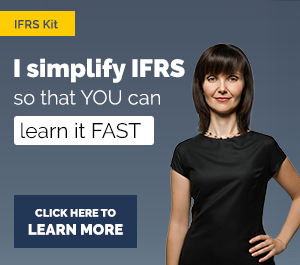How to account for gift cards?
“I am an accountant in a retail chain. We sell clothes, accessories and home decorations.
We also sell gift cards of certain value. For example, a customer can purchase a gift card of 100 CAD and give it to someone else as a birthday present. Then the person can come to our store, buy our products and pay with the gift card.
When we sell a gift card, we account for is as revenue, but our auditors say this is not in line with the new standard IFRS 15. Is it true? How can we account for gift cards?”
Answer: your auditors are right
You should NOT account for the sale of gift card straight in revenues.
Why?
The reason is that IFRS 15 requires recognizing revenue when you satisfy a performance obligation.
In this case, gift card itself is NOT a performance obligation.
It is just a prepayment for the future delivery of goods. The customer gave you money for the gift card now and you will have to deliver the products later when someone else will come and want to use that gift card to pay.
How to account for the gift card at the moment you sell them?
IFRS 15 specifies it in the implementation guidance – paragraph B44.
Gift cards are in other words customer’s unexercised rights that will be exercised in some future point.
You have to recognize the amount attributable to that unexercised right as a contract liability.
When the customer comes to your store, buys some clothes and pays with the gift card, this is the moment when you remove the contract liability and recognize revenue from sale.
The reason is that at that moment, you satisfied a performance obligation, in other words – you delivered goods to your customer.
How to recognize revenue from unexercised services?
Well, this is called also breakage – prepaid, but unused service by the customers.
You need to recognize it as revenue in proportion to the pattern of rights exercised by the customer.
In the case of your gift card, it depends on how the customer can use it:
- If the customer can use it just for one payment, then you recognize it as revenue when the customer uses it.
- If the customer can use it for more payments until she spends the full amount, then you would recognize revenue proportionally.
What happens if no one comes to redeem the gift card?
Yes, that happens a lot.
You sell a gift card and no one comes.
In this case, you should recognize revenue from breakage when the likelihood of the customer exercising its rights becomes remote.
For example, if the gift cards have some validity period, then you can recognize the revenue from breakage or unused service after the period lapses.
If the gift cards have no validity period and are valid forever, then you should have some past statistics to assess how much time needs to pass before the customer forget about unused gift cards and never come.
Careful – gift cards with regular purchases
It can happen that you provide a gift card for free as a bonus with bigger purchase.
In this case, you have to split the transaction price and allocate it to the sold products and to the gift cards in proportion to relative stand-alone selling prices.
Example: Providing gift cards as a bonus with bigger purchases
Let’s say you offer free gift 10-euro gift card if the customer makes a purchase of more than 100 EUR.
The customer purchases the goods for 100 EUR and she gets the gift card for another 10 EUR.
The total transaction price is EUR 100 because that’s what you get from your customer for goods and gift card.
You need to split the transaction price of EUR 100 between the individual performance obligations based on the relative stand-alone selling prices.
The allocation is in the following table:
| Performance obligation | Stand-alone selling price | Allocated transaction price |
| Goods | 100 | 91 (100/110*100) |
| Gift card | 10 | 9 (10/110*100) |
| Total | 110 | 100 |
Your journal entry at the moment of sale and giving out the gift card is:
- Debit Cash received: 100
- Credit Revenue from sale of goods: 91
- Credit Contract liability (gift cards): 9
Now, the gift cards are valid only for 1 month.
If the customer comes, buys the products for 10 EUR and pays with the gift card, your journal entry is
- Debit Contract liability (gift cards): 9
- Credit Revenue from sale of goods: 9
You also need to book the cost of sales related to the delivered products.
If the customer does not redeem the gift card and the validity period lapses, then your journal entry is the same, just the revenue would be titled something like “revenue from breakage” or so.
Here, you have no cost of sales, because you did not deliver any products.
This was very simplified explanation, because I omitted the probability of redemption.
Normally, companies need to estimate the probability of redemption and incorporate it to the total transaction price of gift cards.
Any questions? Please write me in the comments – thank you!
Tags In
JOIN OUR FREE NEWSLETTER AND GET
report "Top 7 IFRS Mistakes" + free IFRS mini-course
Please check your inbox to confirm your subscription.
30 Comments
Leave a Reply Cancel reply
Recent Comments
- Janez on IAS 16 Property, Plant and Equipment – summary
- Chandan Kumar Singh on How to account for gift cards?
- Silvia on How to calculate deferred tax with step-by-step example (IAS 12)
- lino Rosas on How to calculate deferred tax with step-by-step example (IAS 12)
- Silvia on IFRS 18 Presentation and Disclosure in Financial Statements: summary
Categories
- Accounting Policies and Estimates (14)
- Consolidation and Groups (24)
- Current Assets (21)
- Financial Instruments (56)
- Financial Statements (52)
- Foreign Currency (9)
- IFRS Videos (71)
- Insurance (3)
- Most popular (6)
- Non-current Assets (54)
- Other Topics (15)
- Provisions and Other Liabilities (45)
- Revenue Recognition (26)
- Uncategorized (1)




Hi I have a query related to Gift card. Accouting & Reporting part is understood. But there is a problem about the documents.
I have sold gift card to a company ABC Ltd
100 Gift Voucher @5000 Each Ie. 500000/-
Now ABC is aking me raise a Invoice so that then can make a bank payment. They are asking, without a proper invoice how they will pay via Bank. How to proof this transaction to tax authority.
If we will raise a invoice for Gift card. Then there would be one more invoice will be raised at the time of redeemption. So how to solve this issue..??
What document should be create at the time of Sale of Gift voucher
Hi Sylvia, i have a situation of gift card that my client sold a gift card at $300 bundle with Face value of $350 I.e the customer got a bonus card of $50), so in this case, the contract liabilities should be Dr. Cash $300 with amount received from the customer and Cr. Contract liability $300 ( allocated to the stand alone price ).. how is the bonus $50 discounted gift card be accounted for. If fully redeem the customer will received products totaling $350 by just spending $300. Is this $50 a discount or a marketing expense
Hi Kevin,
if the gift card is fully redeemed and the customer gets discount on the same purchase (thus not as in the example above where the discount is for the next purchase), and let’s say that cost of these items in your inventories is 200 USD, the full selling price is 350 USD and gift card value is 300 USD, then upon redemption of that gift card in full value, you will book:
Dr Contract liability 300
Cr Revenue from sales of goods 300
and of course cost of sales:
Dr Cost of sales 200
Cr Inventories 200.
You do not book the discount of 50 EUR anywhere – because that discount is already reflected in the transaction price, which is in accordance with IFRS 15.
Hi Silvia,
I am not sure how this aligners to the IFRIC Interpretation committee 8-9 September 2015, where it was stated that a gift card with no expiry date should not be recognised and breakage revenue should not be recognised. See below: those IASB members acknowledged the consequence of this classification
as a financial liability and the view that the application of the derecognition requirements in IAS 39 / IFRS 9 would result in the financial liability for the unused balance on the prepaid card remaining in the bank’s financial statements in perpetuity, even if the customer is not expected to use the prepaid card. However, few IASB members expressed a view in favour of an amendment of IFRS 9 (or IAS 39) to reflect the breakage in the bank’s.liability related to the prepaid cad.
Is there any update that I miss?
Thanks
Matt
Hi Matt,
that is slightly different issue, because IFRIC discussed a situation of prepaid cards, where the issuer has an obligation to deliver cash to specified merchants on behalf of the card holders. In other words, that was the prepaid card which can be used in various different merchants. My article speaks about the gift cards solely used in that particular shop belonging to the entity, where the entity has no other obligation than deliver goods or services to the customers. I hope it makes sense.
When a company charges an inactivity fee after 24 how should this inactivity fee be accounted for and should it be accounted for up front or after 24 months
Thanks Dear.
Dear Salvia,
Our Company receives inventory as donation from foreign vendors. The Vendor also shares the Invoice of inventory (cost of purchase) with our company. However, the same product are locally available at lower, therefore NRV is less than Purchase cost. What should be the cost at the time of initial recognition of inventory ? NRV or the purchase price of Vendor ?
Hi Hussain,
you should take a look at this article. S.
Dear Silvia
Please advise the accounting treatment for the the sale of $100 gift voucher for the $200 purchase of goods.
Thanks
Thanks, Really very helpful article.
Hello, thanks for the great article.
How about gift card sold with a vehicle (automotive company)?
We sell a vehicle and a gift card together. Customer pay for a gift card in the vehicle price. He can redeem voucher in next periods. Should we recognize contract liabilty? How about future costs? We will have to cover costs of servcies or purchases of spare parts, but customer will not pay for them becuase he has the gift card and will redem it. Could you please explain how should we account for such situation?
Thank you in advance!
Hi Jeny,
you need to perform the step 4 in 5-step revenue recognition model first, and then account for the gift cards with allocated price as in line with this article. So let’s say the sales price of car+gift card is 100, stand-alone price of car is 90 (without gift card) and stand-alone price of gift card is 20; then you need to allocate 90/(90+20) to the car and 20/(90+20) to the card. And then you account for these 2 things separately. If you have no stand-alone selling prices, you can choose alternative way (fair values). I hope it helps.
I want to Understand the Standards of IFRS & IAS, I always read these Standards but I can not Clear Concepts from my book.
Please Give me Advice that standards or How can I increase my knowledge about this Standards?
When a Medicine Company Provide some “Physician Sample Free”
How can I Treatment that in the books of accounts
Please give the Journal Entry
Hi Ali, maybe this article will help.
Thanks, for your good Topics or Link
Does the same application apply if the gift card is from a 3rd party provider? Eg We make a year end variable bonus to the customer for reaching a target and in return give ‘social’ gift cards (issued by a government agency for eg food staples) Should this also be included in the sale price?
Ultimately bonus is paid in gift cards – but the argument against is that it’s not due to inability to sell or transfer due to only being able to use it at certain locations
Hi there, i found a situation of gift card that my client sell a gift card at $45 (Face value of $50), so in this case, the contract liabilities should be Dr. Cash $45 and Cr. Contract liability $45 and whether is correct if i ignore the $5 discount of gift card face value in today of selling gift card?
Hi Alvin and Silivia,
Whats the treatment for the $5 discount as its a cost or reduction in sales for the client when the customer tender the card
The discount of 5 USD is reflected in the transaction price, thus the sales revenue is just 45, not 50.
Silvia thanks for the post. Kindly explain it in the perspective of an agency in a service industry that has received a gift card from the airline how does it account for it. Thanks
Hi Canary, there are no exact rules on this topic in IFRS, but you should assess the bonuses received from supplier in a greater perspective in relation to your contract/other services purchased. For example, it can reduce your purchasing cost of all other flights (if you are a travel agency organizing trips and you buy a lot of flights + you receive some at no cost). Also, it is very important to determine the correct moment of recognizing the bonus received. Sorry, I can’t be more precise here, because it really depends on the specific situation. S.
Awesome. Love it
Hi When there is no claim for a gift card, then it is getting recognized as revenue on the expiry of the period, the Corresponding cost of sales are not being booked as there is no actual delivery of goods. But, then, don’t you think that this is contradictory, as it defeats one of the cannons of accounting which is the cost matching concept. Thanks.
Hmhm, and what costs would you like to book in this case? You effectively got money and provided nothing, because your customer did not apply the gift card. So you have no costs to book.
Silvia, thank you for your blog post.Really thank you! Awesome.
Hi When there is no claim for a gift card, then it is getting recognized as revenue on the expiry of the period, the Corresponding cost of sales are not being booked as there is no actual delivery of goods. But, then, don’t you think that this is contradictory, as it defeats one of the cannons of accounting which is the cost matching concept. Thanks.
Dear Venkat,
no, I don’t think it’s contradictory, because there is nothing to match with the revenues. Please remember that the company earned money just from selling the gift card and NO corresponding delivery of goods occured as the gift card expired. S.